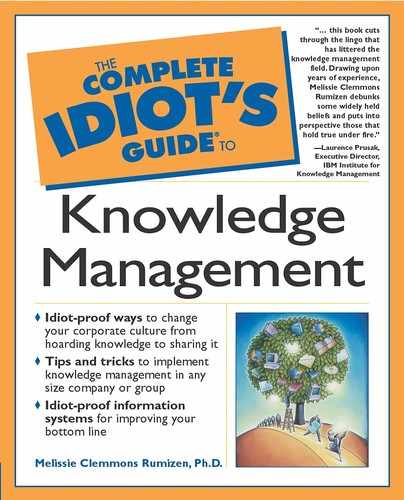
Chapter 7
Building the Infrastructure
In This Chapter
▶ Deciding where KM belongs
▶ Doing the budget
▶ Creating new roles
▶ Forming a steering committee
When people talk about knowledge management at conferences, the presentations often make you feel as though you came in half an hour after the movie started. Somewhere in the first reel important decisions were made, like deciding where authority for KM should reside in the organization, who does what, and how a budget gets approved. You wish they would start again at the beginning.
You also wonder if these people were operating in isolation on a studio back lot. Where were the studio executives? Weren’t any key players in the organization involved? Surely these folks didn’t start a major initiative without involving some of the senior people in their organizations.
The reason you don’t hear more about these things at most conferences is the limit on time for presentations. Most speakers do the best they can, but the normal conference slot only allows for highlights. You’re right, though, in thinking these are important issues. In this chapter, we will go back to the first reel.
Deciding Where KM Belongs in the Organization
Knowledge management efforts perch almost everywhere on organizational branches. A common home is the information technology organization. Other perches include
▶ Office of quality management.
▶ Research and development.
▶ Human resources.
▶ Corporate universities.
▶ Individual divisions.
▶ Individual business lines.
▶ Support functions such as services, legal, or corporate strategy.
▶ E-business efforts.
Some KM efforts even stand alone, reporting directly to the CEO or another top-level executive.
There is no single right answer for where KM belongs in your organization. However, there is a key question that might be helpful: What kind of organizational structure do you have? Is it decentralized or centralized? Many organizations are one of those two types: decentralized with numerous autonomous business units, or centralized with a strong governing core.
Decentralized Organizations
This type of organization has many business units that have a strong degree of autonomy. The units may allocate capital themselves, set policies, and determine business objectives. Organizations set up autonomous units to allow for flexibility in meeting customer needs in different market sectors. The independence of these units lets them respond quickly to changes in their particular environments.
Both Hewlett-Packard and British Petroleum are companies that are largely decentralized. While the goal of many organizations is to become global businesses, management also recognizes the need for autonomy of different units, and decentralization is the result.
The downside to being decentralized is that it becomes harder to be consistent across the organization about anything. For example, information technology may not be standardized across the whole organization, making it hard for different units to communicate and share information. Important policies and procedures may vary. Often there is a lack of corporate identity. People often see themselves as belonging to their unit, not to the larger organization.
All of these are barriers to sharing knowledge. Interestingly enough, however, being decentralized can also be a driver for knowledge management. This can happen if senior leadership recognizes this weakness and the potential for improvement that comes from implementing an effective knowledge management initiative that gets employees communicating and sharing.

Know How
An option for a decentralized organization is to put together a core KM group but keep it small. The real work is done out there in the units. The central group can provide expertise for unit projects while keeping an eye out for consistency across the organization. The key for such a group is to realize that it can suggest but cannot command and control. It has to earn the willingness of the units to collaborate with the KM group. It’s a delicate dance to assist an autonomous unit.
One example of decentralization driving knowledge management is the communities program at Chrysler. In 1987, Chrysler reorganized into separate platforms for different vehicle types, such as small cars or trucks. This dramatically cut the cycle time for new vehicle design.
However, the reorganization had a downside. It moved experts who had been in a central group into the different platforms. The engineering experts became isolated from one another. They no longer could learn from each other, help each other out with problems, and share new ways of doing things.
Chrysler compensated by forming communities of practice among the engineering specialties, calling them its “engineering tech clubs.” These tech clubs also created and maintained a best-practices repository called the Engineering Books of Knowledge to which all engineers had access, to their mutual benefit.
If your organization is decentralized, the best home for a KM effort could be in one of the decentralized units. That’s how the organization is used to operating, so it will be a natural fit. Hewlett-Packard Consulting’s KM effort is housed in and targets that group. However, that does mean that your KM effort only targets that unit.
Centralized Organizations
Centralized organizations have a strong governing core. This structure works well when there is a high degree of interdependence among different parts of the organization, with little local variation and a need to operate jointly. This kind of organization needs to mesh together as tightly as the gears in a machine.
The downside to a centralized organization is that it can be a sluggish bureaucracy with rigid policies. At the local level the central organization can seem like a distant despot indifferent to the needs of the local populace. Although the organization can act globally effectively, it is poor at reacting to local events.
If you have a centralized organization, it may make sense to plunk the KM effort at corporate headquarters. Again, it is a natural fit with how the organization runs. In such an organization there is a greater chance of developing and implementing corporate-wide polices and programs. A centralized organization can establish these.
Even corporate efforts inside centralized organizations may not have enough people to do all of the work needed in the rest of the organizations. Core KM teams usually are small. Like the core teams in decentralized organizations, these teams need to provide expertise and guidance but not do all of the actual work.
Home Sweet Home
The bottom line is that KM needs a cozy home, just like a KM pilot. In that cozy home you must be able to
▶ Make decisions in how to invest for KM.
▶ Get funding.
▶ Get the access you need to senior leadership.
▶ Make sure that resource allocations are in line with the organization’s overall strategy and also the knowledge management strategy.
Often the organizational leader can be the deciding factor in picking a cozy home. Again, like a KM project, you want the leader of the organization to be a vocal supporter of KM, perhaps your executive sponsor.
At the least, the leader must provide a home for the KM initiative as well as help obtain funds and be tolerant of your effort.
Tolerance, of course, is a far cry from a fervent support. It’s never my first choice. But it may not be as bad as it sounds. Having a perch gives you the toehold you need to prove the value of KM. After all, in most organizations so much needs to be done that almost any perch will give you a chance to do work that will have impact.
Doing the Budget
What you budget for will be determined by what your needs are. Don’t think too narrowly, though. Some important considerations for you are
▶ Ongoing development of your core team.
▶ Continuous learning.
▶ Membership in outside organizations and consortia.
▶ External consultants.

Didn’t Know
Psychological research has shown that once people make even a small commitment to something, they have a need to be consistent. We have internal pressures that needle us to respond in ways that agree with our initial decision. On a practical level, this means you should never underestimate the power of getting even a small commitment.
▶ Celebrations.
Exact details for budget processes vary by organization. Different organizations go through the budget process at different times of the year. They require different submissions.
There is one rule, however, that applies across the board, regardless of your organizational requirements: Submit a budget with differing levels of funding. Prepare one with low, medium, and higher amounts of money (which I like to think of as dirt cheap, reasonable, and limited deluxe).
It’s easy to say no to one option, but for many decision makers, it seems unreasonable to turn down a request with multiple options. It’s like refusing to eat anything on a buffet. The temptation is to pause, look over what is available, and try a few things.
Giving a number of options will require more work on your part. You will need to write up a clear justification of expenses at each level, with a list of benefits you expect. You’ll also need to think out the different resources you’ll need for each level. Also, be prepared to mix and match as you go through the budget process. In short, you’ll wind up doing several budgets, not one. But it’s an exercise you must go through to get your funding.
Developing Your Core Team
You and your team members may want to attend some conferences, take some courses, or do other things to pick up additional skills. One skill, for example, that is almost universally applicable for this kind of work is facilitation. Facilitation concerns ways of helping a group work together more effectively. You may want to train several people in facilitation.

Know These
Facilitation refers to skills used to improve group interactions. This includes conducting meetings, reaching consensus, resolving conflicts, improving relationships, and managing group tasks. In a team environment, the facilitator only addresses the group interactions, not the actual content. For example, in a meeting the facilitator might suggest using a particular method to reach consensus, but not a solution to whatever problem the team is discussing.
Knowledge management is a fast-evolving and expanding field. You can’t stand still and let the KM world go by. Even if you have already done a lot of research, keep learning. This is also a diverse field. You may have overlooked something you need. Continue to scout for approaches, techniques, research, and processes that could be helpful to you.
Outside-the-Organization Memberships
Outside organizations are a great source of learning. Some of these organizations are stand-alone nonprofits. Two examples are the American Productivity and Quality Center (APQC) and Knowledge Management Consortium International. Colleges and universities such as Henley College in England and the University of Saint Gallen in Switzerland sponsor consortia and organizations as well.
Also look for government-sponsored or -affiliated consortia. In a growing number of countries such as Singapore and Finland, knowledge management is a critical issue on the government’s agenda. Organizations such as IBM sponsor some consortia as well. All of these offer you a chance to network with those in the field and learn from them. Many current practices are too new to have been written down; the best way to learn is to talk to someone who’s doing it.

Know How
You may want to form your own consortium. Intel Corporation formed a partnership with Siemens. Together they hold meetings about knowledge management topics, bringing in outside speakers in areas like communities of practice.
Fees for membership vary. Check out the pricing structure and the deliverables. Compare the deliverables against your goals. Get involved with a consortium that is consistent with your strategic approach to KM.
Celebrations
Being a revolutionary is a sometimes heart-breaking business. You will have defeats. Your team can get beaten down and discouraged at times. Counter the losses with celebrations of the wins. Budget a little money for a pizza party, T-shirts or mugs, or gift certificates for the group.
You may be surprised at the effect this will have on your team’s morale and motivation. Even a small celebration says that the hard work is worth it and keeps the momentum going.
Creating New Roles and Funky Titles
Once you start building the KM infrastructure, you have your opening to create new roles and titles for those people who will be involved in executing the KM initiative. Part of the budgeting process will include deciding what roles you’ll need people to fill and that you’ll need to fund. You’ll have to think out the things you want people to do, both as members of the KM team and elsewhere in the organization. You may discover that you need people to act in new roles.
The first place to start is with your own team. As most KM teams are small, there’s a greater need to work closely with other parts of the organization. Again, the real work is done out there in the organization, not inside your KM team. Hewlett-Packard Consulting found that they needed people to provide knowledge management services to the field organization. Their knowledge services managers worked closely with the different geographical regions to help them plan and use the available KM services and tools.
In your KM team you also need to have people who design systems for knowledge and the supporting information technology. Hewlett-Packard Consulting created knowledge architect positions to develop these systems for use of knowledge processes and access to knowledge. Particularly in decentralized organizations these people are critical, for their job is to see the whole, not the parts. For knowledge sharing, you need to connect the entire organization.
Another role is the chief knowledge officer, as we discussed earlier in Chapter 3, “What’s a Chief Knowledge Officer?” Someone needs to be in charge. Out where the real work is done, you also may need to look at roles to support knowledge processes, both for your pilot(s) and ongoing efforts.

Know How
Any major change or innovation takes time. You’re not going to reach your vision overnight. However, human beings need interim successes. We need to see concrete evidence that things are beginning to change. Look for short-term wins that are relatively unambiguous that you can link to what you’re doing.

Know How
Any KM team must have a thorough understanding of the organization’s current information technology infrastructure: its capabilities, strengths, weaknesses, flexibility, and future plans. As well, a team must understand both current knowledge management technology and new trends. Predicting technology trends is worse than fortune-telling, but you need to make the attempt.

Didn’t Know
The Delphi Group, a major KM consulting company, looked at knowledge leadership roles in its research on best practices in knowledge leadership. Among the companies they studied were British Petroleum, Warner Lambert, Hallmark Cards, and Dow Chemical. Some of the roles they found were
▶ Knowledge engineer, responsible for taking explicit knowledge and turning it into more useable forms such as instructions, programs, and codified applications.
▶ Knowledge analyst, responsible for collecting, organizing, and disseminating knowledge.
▶ Knowledge manager, responsible for coordinating the activities of other roles such as knowledge engineer and knowledge analyst.
Researchers at the IBM Institute for Knowledge Management discovered three distinctive roles:
▶ Knowledge stewards. They capture and codify tacit knowledge. They usually conduct interviews or observe and capture knowledge from internal sources. Additionally, they encourage people in the organization to actually use the documented knowledge. This may involve training people how to use the system.
▶ Knowledge researchers. They search, retrieve, and transfer knowledge that’s already been codified. The old, familiar corporate librarian is one example of a knowledge researcher. These folks have skills in defining information requests, changing sometimes-vague requirements into doable searches.
This new breed of researcher does a lot more than answering information requests. They push information to people they know have specific interests. They also look for new topics that could be of value to an organization. Immersed in the flow of organization information, they are able to spot trends.
▶ Knowledge brokers. They connect people to people. They know who you need to talk to, and they connect you with that person, and then bow out of the picture. Knowledge brokers usually have strong personal networks. And since they understand both the person making the request and the person with the knowledge, they can wind up translating between the two people they are connecting.
Knowledge brokers can be hard to find. Their actual capabilities usually have nothing to do with their job titles. It seems to be more a matter of temperament and willingness to assume the role. Once you find one, however, cherish him or her. In a knowledge-sharing organization, the knowledge brokers are royalty.
Another important role is that of community coordinator for communities of practice. We will talk about that one in Chapter 8, “Communities of Practice—The Killer Application.”
Forming a Steering Committee
A running theme in this book is that you need co-conspirators. The more co-conspirators you have in senior management in various functions across your organization, the better off you will be. Like the individual workers in your pilot projects, people who participate and guide an effort have more buy-in. This buy-in, which is separate from normal everyday business processes, can speed the adoption of knowledge management.
Having a steering committee with representatives from various functions also gives you better solutions. You get input from various views and types of expertise. You get a better big picture of the organization, helping you to prioritize resources. This can also help you bypass organization silos, creating a catalyst for change across the organization.

Know How
Have a facilitator work with your steering committee on decision making. Discuss what types of decisions you’ll be making, such as strategy, funding, and recommendations. For each type of decision, agree on who has the final authority. Chart this so the results are visible. Also, plan how you will reach consensus and what type of consensus you want.

Know These
Organization silos is a term that refers to individual groups or departments in an organization. It’s often used to suggest that such groups, while they work well as a team, seldom take into account what other groups are doing or how their work affects what these other groups do. This is both common and unhealthy.
While you want the steering committee to contribute ideas, this also can put you into a quandary. Up front, you must make it clear who has the authority to make what kinds of decisions.
What if the steering committee advises a course of action that is contrary to what you, as chief knowledge officer, think is best? When you are chartering a steering committee, the time to raise this specter is during the initial meetings.
You and your KM team by virtue of your expertise will fill a leadership role for the steering committee. Part of your goal for a steering committee is to increase its understanding of knowledge management. You also will assimilate and evaluate the recommendations of your steering committee. Possible sources for members of the steering committee are
▶ Human resources.
▶ Information technology.
▶ Marketing.
▶ Sales.
▶ Quality management.
▶ Organizational development.
▶ Corporate communications.
▶ Key business units.
▶ Different geographical areas.
▶ Line managers.
▶ Corporate library, if you have one.
You also want to choose people who have good reputations, good relationships, an interest in what you’re doing, and the ability to lead.
Also think about forming a second steering committee of other people with experience and expertise in knowledge management. The people in knowledge management roles elsewhere in the organization are good candidates for members. People in efforts you have “claimed” as knowledge management also are potential members. This group can function as a larger pool of KM experts. Additionally, they can help you to document the lessons learned.
The Least You Need to Know
▶ There is no right answer for where KM belongs within an organization.
▶ A good strategy for developing a knowledge management budget is proposing multiple levels of investment with varying levels of return.
▶ Implementing knowledge management programs requires creation of new organizational roles, both within a core KM group and throughout an organization.
▶ Forming a steering committee of senior leaders is another critical success factor for knowledge management.
▶ Consider putting together a steering committee of knowledge management experts to form a larger pool of experience and expertise.
..................Content has been hidden....................
You can't read the all page of ebook, please click here login for view all page.
